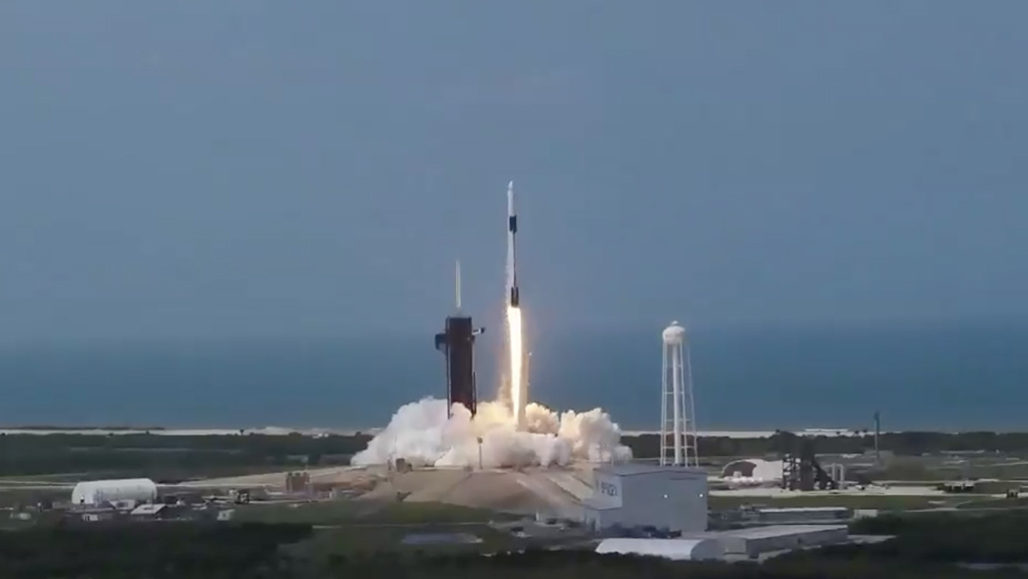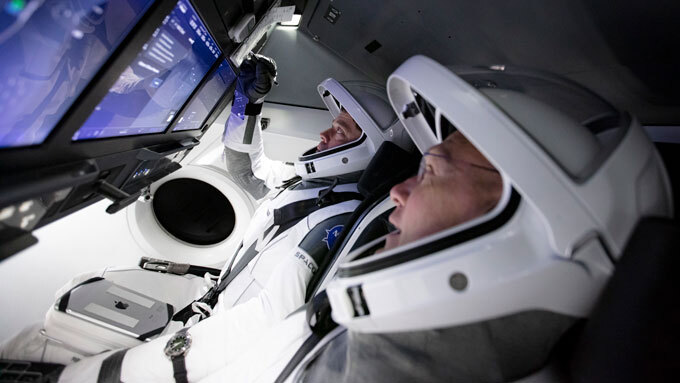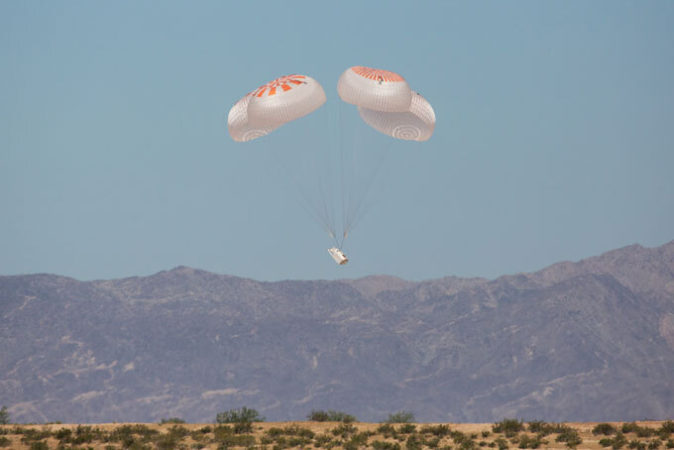A first: Commercial rocket takes humans into space
It’s also the first U.S. launch of astronauts since 2011, when NASA’s shuttle program ended

Two NASA astronauts lifted off from the Kennedy Space Center in Florida on a SpaceX Falcon 9 rocket on May 30. This was the first crewed launch of a spacecraft from the United States since the shuttle program ended in 2011.
NASA
On May 30, a commercial rocket for the first time ferried astronauts into Earth orbit.
SpaceX’s Crew Dragon spacecraft took off at 3:22 p.m. EDT from the Kennedy Space Center. That’s in Cape Canaveral, Fla. It carried U.S. astronauts Doug Hurley and Bob Behnken to the International Space Station (ISS).
Called Demo-2, the launch and flight is the ultimate test of the ability to use this new system to take a crew into orbit. The Falcon 9 rocket then returned to Earth and safely landed on a floating platform.
“So rises a new era of American spaceflight,” said Dan Huot of NASA, shortly afterward — “and with it the ambitions of a new generation continuing the dream.”
The launch had been slated to take place three days earlier. Bad weather scrubbed the launch fewer than 17 minutes before lift-off time.
This was the first launch of astronauts from the United States since 2011, when NASA’s space shuttle program ended. Since then, Russian Soyuz spacecraft have been the only way for any astronauts to reach the space station. (The Chinese space agency has its own rockets and crew vehicles. It also had its own space station for a time. But China is not a partner in the ISS.)
The new launch held a special meaning for its two passengers. Both astronauts had flown on two space shuttle missions. Hurley was on the final shuttle flight, in July 2011. “It is absolutely our honor to be part of this huge effort to get the United States back into the launch business,” said Hurley just before launch.

Using a private company marks a big transition in human space travel for NASA. Until now, the space agency had complete control over U.S. launches. Now it will become just another customer for a private company. That shift should end the U.S. space agency’s reliance on Russia. It also would free NASA to focus on more complicated missions, such as sending humans to the moon and Mars.
Jonathan McDowell works at the Harvard-Smithsonian Center for Astrophysics. It’s in Cambridge, Mass. “The reason you have NASA is to push the envelope, do things at the frontier,” this astrophysicist says. “Low-Earth orbit and the space station are no longer the frontier. So you just hire a trucking company.”
An issue of money
In 2014, NASA partnered with the companies SpaceX and Boeing to develop new flight technologies. At that time, NASA was looking for new ways to get astronauts into orbit and back.
NASA had hired private companies, including SpaceX, to launch satellites for years. The space agency also used private companies to develop parts of spacecraft since the 1950s. But human space exploration had higher stakes.
“It has a much higher public profile, and much worse consequences, if things go wrong,” McDowell notes. “It has been a big attitude shift within NASA to get this far. But I think it is the right time to do it,” he says of using private companies for astronaut launches.
NASA gave SpaceX funding and technical oversight for its development of the Crew Dragon. “What we’re doing is unlike anything we’ve done before,” NASA administrator Jim Bridenstine said in a May 27 NASA TV broadcast. “We are not purchasing, owning and operating the hardware,” he noted. “We’re turning to commercial industry…. We’re really revolutionizing how we do spaceflight.”
This was a good deal for the agency, according to the Planetary Society. On May 19, it published an analysis of the costs involved. NASA’s share of costs for developing Crew Dragon over the last nine years comes to about $1.7 billion. That’s far less than NASA spent on every other crewed spacecraft project in the agency’s history. For instance, if you account for inflation (the buying power of a dollar over time), NASA spent $2.7 billion developing the Mercury spacecraft. They were used for the first U.S. human spaceflight program, between 1959 and 1961. The development of the space shuttle program cost a whopping $24.7 billion.
A pre-launch quarantine
Hurley and Behnken spent the two weeks before launch in quarantine. This was to ensure that they didn’t bring any infections or illnesses — including the new coronavirus — to the ISS. That practice was in place long before the emergence of COVID-19, notes Stephanie Schierholz. She’s a spokesperson for NASA.
Once the coronavirus pandemic emerged, NASA followed recommendations from the Centers for Disease Control and Prevention. Even before the astronauts went into quarantine, she says, NASA began “cleaning [all] surfaces, social distancing, emphasizing hand hygiene, encouraging NASA team members who are sick to stay home and limiting contact with crew members.” The astronauts also have been tested at least twice for COVID-19.
NASA maintains a pharmacy on the space station. And it plans to sequester its astronauts from their crewmates if anyone gets sick. (There are, however, no plans to send coronavirus tests to the space station.)
The coronavirus pandemic also meant the Kennedy Space Center was closed to the general public. Crowds watched the launch from nearby beaches and roads anyway.
The new NASA mission won’t be considered over until the astronauts return in the same Crew Dragon capsule. No one is yet sure when it will be — probably in one to three months.

This was a trial mission. Once the SpaceX craft is certified safe and operational, Crew Dragons will carry up to four astronauts at a time on NASA missions to the ISS. NASA hopes that the new transports will help boost its ability to carry out research that can be done only in space.
For his part, Behnken is excited to be launching from the Florida coast again. That had been routine when he and Hurley joined NASA’s astronaut corps in 2000. He said that letting people get “a chance again to see human spaceflight from our own backyard, if you will, is pretty exciting to be a part of.”







